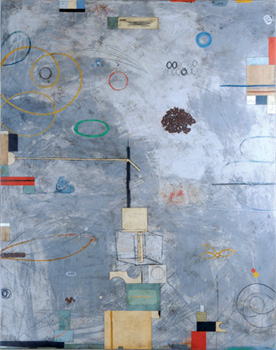
Over the last several years Denver painter Don Quade's work has been changing. When he first started to show his pieces some years ago, the influences of Latino folk art predominated, but there was also more than a little dash of the minimalism originally conjured up by his friend and fellow Denver artist, Emilio Lobato. As Quade has matured in his style, the folk art references have receded somewhat, and though he's still stylistically connected to Lobato, this latest work at Walker is distinctively his own.
Quade has written rather poetically that his new paintings are about "the gaps between what we know for certain and what we allow ourselves to dream," so maybe that's why there are apparent riffs on Dada and Surrealism in many of the paintings. These retro qualities are particularly easy to see in a piece such as Babylon. In the bottom center of the picture, Quade has drawn a rendering of a hypothetical contraption made up of simple vessels that's very Duchamp. And scattered across the picture plane are a profusion of little squiggles and forms that are widely spaced, recalling the compositions of early Miro. Despite all the minuscule drawn and painted shapes that appear--not to mention the rectilinear blocks of color made from the incorporation of collage elements--the pieces at first blush are fairly airy and simple in appearance, at least from a distance. That's because the paintings are mostly made up of monochromatic fields of muted desert shades, along with black, which occupy the majority of the pictorial space. These fields act as a backdrop for everything else that's going on in the work. To achieve these backgrounds, Quade applies a coat of color to the wooden panel that is the basis for all his paintings. This is followed by another coat, and so on. Then as he's incorporating his drawn elements and his collaged ones, he rubs and scuffs the paintings in places. As a result, the colors in the lower coats are revealed at the painting's surface. Also unifying and thus simplifying the pieces is the fact that all are sealed with even layers of transparent glazes. Like most contemporary artists, Quade's work has lots of international referents. However, it's also undeniable that his signature approach, particularly his palette and his surface effects, resonate with the long-established look of abstract art in Colorado and New Mexico.
This article was written for and published in art ltd. magazine ![]()
